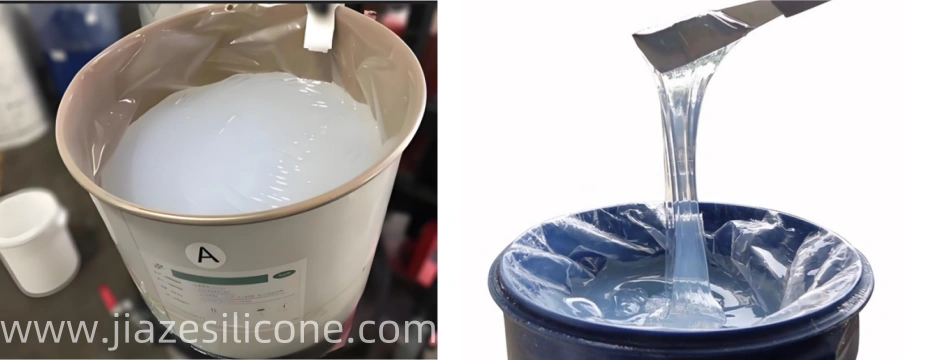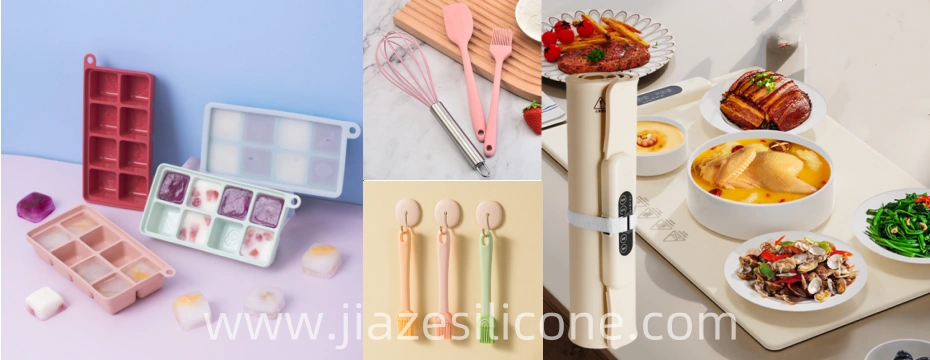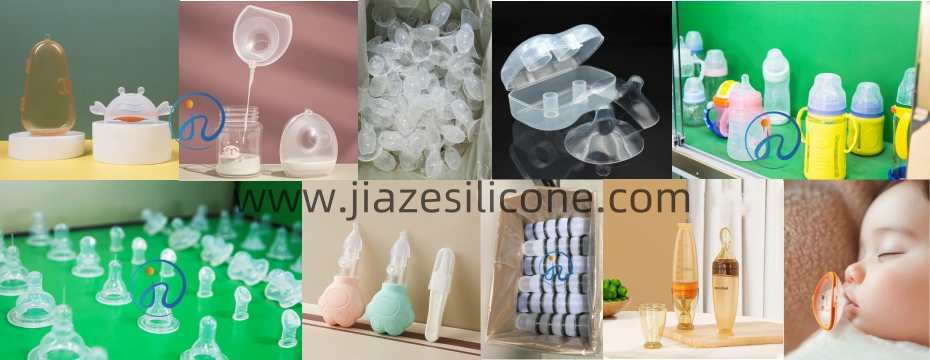Food grade liquid silicone rubber (LSR) is a specialized type of silicone material that meets stringent safety and health standards for food-contact applications. This material is highly versatile, non-toxic, and resistant to a range of environmental factors, making it an ideal choice for products used in food processing, handling, and storage. LSR is used to manufacture a wide array of items, from kitchen tools to medical devices, that come into direct or indirect contact with food.
What is LSR?
Liquid Silicone Rubber (LSR) is a two-part system (A and B components) that, when mixed in specific ratios, undergoes a curing process that transforms the liquid into a flexible, durable, and heat-resistant rubber. It is known for its excellent thermal stability, low reactivity, and resistance to extreme temperatures. When formulated as “food grade,” the material adheres to regulations and standards, ensuring it is safe for use in food-related applications.

Composition of Food Grade LSR
Food-grade LSR is composed of high-quality silicone polymers that are free from harmful additives and contaminants. These polymers are refined to avoid the presence of substances that could potentially leach into food products, posing health risks. Additionally, food-grade LSR is often free from heavy metals, plasticizers, and other harmful chemicals that might be found in non-food-safe silicone products.
Some common components of food-grade LSR include:
- Silicone base: The backbone of the material that gives it its rubber-like properties.
- Curing agents: Chemicals that trigger the cross-linking process to solidify the silicone once it has been applied.
- Fillers: Certain fillers may be used to modify the properties of the LSR, though these must also comply with food safety standards.
- Colorants and additives: If used, these must meet food safety certifications and should not affect the material’s non-toxicity or overall safety.
Properties of Food Grade LSR
Food grade LSR boasts a range of properties that make it suitable for a variety of applications in the food industry:
- Non-toxic: It is manufactured in compliance with international food safety standards, including FDA (U.S. Food and Drug Administration) and EFSA (European Food Safety Authority), which ensures it does not leach harmful chemicals into food.
- Temperature Resistance: LSR can withstand extreme temperatures, ranging from -50°C to over 250°C, without degrading. This makes it suitable for both high-heat cooking processes and freezing conditions.
- Chemical Resistance: LSR is resistant to a wide range of chemicals, including oils, greases, and food acids, making it ideal for food processing environments where such substances are prevalent.
- Durability and Flexibility: LSR maintains its structural integrity even after repeated use, bending, or exposure to harsh environments, offering a long lifespan for products.
- Hygienic and Easy to Clean: LSR’s smooth surface and non-porous nature make it easy to clean, and it is resistant to bacterial growth, which is essential for food safety.
- Odor and Taste Neutrality: Food-grade LSR will not impart any unwanted tastes or odors to food, a crucial feature for any material used in food contact applications.
- Biocompatibility: Beyond food, LSR is also used in medical applications, which highlights its compatibility with the human body and its non-toxic nature.
Applications of Food Grade LSR
Due to its unique properties, food-grade LSR is used in a variety of applications across the food industry, some of which include:

- Baking and Cooking Tools: Silicone baking mats, spatulas, molds, and utensils are commonly made from food-grade LSR. These items can withstand high temperatures, ensuring durability and safety during cooking processes.
- Molds and Food Storage Containers: Silicone is used to create flexible molds for chocolate, ice, candy, and other food items. It is also used for storage containers, such as lids or trays, that help preserve food at different temperatures.
- Sealants for Food Packaging: Food-grade LSR can be used to make seals for packaging, ensuring that they are airtight and moisture-resistant, which is essential for preserving the quality of perishable food items.
- Infant Feeding Products: Items like baby bottle nipples, pacifiers, and teething rings are often made from food-grade LSR due to its softness, non-toxicity, and ease of cleaning.
- Food Processing Equipment: LSR is used in gaskets, seals, and other components of food machinery to ensure safety and durability under varying operational conditions.
- Medical Devices Related to Food: Silicone is also used in food-related medical devices, such as feeding tubes or intravenous lines, due to its biocompatibility and resistance to microbial contamination.
Safety Standards and Certifications
Food-grade LSR must adhere to strict safety standards, which vary from region to region. Some of the most important certifications and standards include:
- FDA Approval (U.S.): The FDA provides guidelines for materials that come into contact with food. Food-grade LSR products must be manufactured in compliance with these guidelines, ensuring they are safe for direct or indirect food contact.
- European Union (EU) Regulations: The EU has established food contact materials regulations that require that all materials, including silicone, be tested to ensure they do not release harmful substances into food.
- ISO 10993: This international standard focuses on the biological evaluation of medical devices, but it also applies to food-grade materials. It covers tests to assess the material’s potential toxicity and other health-related impacts.
- LFGB (German Food, Consumer Goods, and Feed Code): The LFGB regulation in Germany ensures that any materials used for food contact are free of harmful substances and will not adversely affect food safety.
- BPA-free and Non-toxic: Food-grade LSR is often manufactured to be free from bisphenol A (BPA), a chemical often associated with harmful health effects.
Advantages of Using Food Grade Liquid Silicone Rubber

- Durability: LSR products typically last longer than alternatives like plastic, rubber, or other materials, reducing the need for frequent replacements and improving cost efficiency over time.
- Versatility: The ability to mold food-grade LSR into various shapes and sizes allows for a wide range of applications in both consumer goods and industrial settings.
- Non-reactivity: LSR’s inert nature means it will not react with food, making it a safe choice for cooking and food storage.
- High-Performance in Extreme Conditions: LSR remains functional and safe even under high heat, freezing, or exposure to oils and fats, which is essential in many food-related applications.
Environmental Considerations
Although LSR is a durable and long-lasting material, it does not break down easily in the environment, which can raise concerns regarding waste and recyclability. However, LSR is often considered to be more eco-friendly than plastics due to its longevity, as it doesn’t need to be replaced as often, reducing overall material consumption. Additionally, certain manufacturers are beginning to explore ways to recycle silicone, though widespread recycling practices for LSR are still developing.
Conclusion
Food-grade Liquid Silicone Rubber is a highly versatile, safe, and durable material with numerous applications in the food industry. Its non-toxicity, resistance to heat and chemicals, and long lifespan make it an ideal choice for products used in food processing, cooking, and storage. As consumers demand safer, more sustainable products, food-grade LSR’s popularity is expected to continue growing, benefiting both food manufacturers and consumers alike.